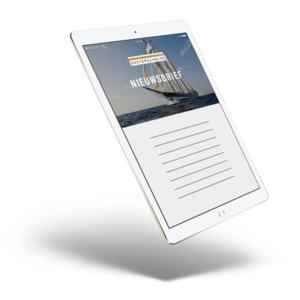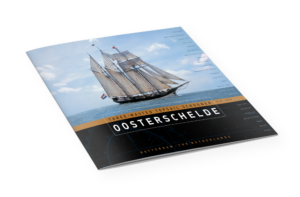03 Dec We did it!
We did it!
3 December 2013
Report by Kaatje:
“Monday December 2 starts as a very normal Monday a/b ‘Oosterschelde’. A new week has started, the fourth. The watches coming of and going up meet each other at breakfast. On a relatively calm swell, people, chairs and carefully covered sandwiches are moving. By now everyone has become used to the movements of the ship. But still there is a bit of hidden tension amongst all present and the ears are sharpened if the words ‘mile’ and ‘hour’ are used. The thing, that for most of us was the reason to start this journey, is nearing: Cape Horn! A rock, speaking to the imagination at 56°11’5″ South and 67°34’8″ West. How far still, still how much? Nobody can tell. It is sure we are sailing in the direction of land! The number of albatrosses, Cape pigeons and petrels has tripled. Also, the first sign of the ‘civilised world’ entered our world last night: a fisherman (whaler?), length 133 meters on his way to Antarctica, one big bulk of light. Soon thereafter, two smaller ships on the AIS. They will also go round the cape, but then in the opposite direction: from East to West. At 10:15 am for the first time since we left the Chatham Islands on November 8: landfall. In the afternoon the odd seal. A number of tumbling dolphins completes the picture; the continental shelf and thereby the cape are really getting closer. The countdown can start! However, the daily routine continues! The daily workshop, this time a presentation by captain Arian about ‘Cable Recovery’, the changes of the watches, peeling potatoes on deck in a shivering snow shower; it still is a normal Monday.
But the 20:00-00:00 watch suspects they might be the ‘lucky ones’ to be the first to cast an eye on Cape Horn. Mate Jana confers with captain Arian from minute to minute about the course to follow: 65 degrees, not 60 nor 70. Which sheet to take in, which sails to trim? The mizzen is furled. And then suddenly, the first of the two lights of Cape Horn can be seen. At 22:50 ship’s time we have passed it. On a distance of 1,1 mile we can see the contours of the cape. This goes to show the real art of navigation, or rather confidence of navigation. In the meantime, all hands have been woken up and have assembled on deck. The solemn ceremony can begin. An a capella choir of four ex-high school boys start to sing a self composed song in Latin: “Viri fortes esse debent” which translates as “hardy sailors they must be”. Above the hauling of the wind, blowing with force 8 Bft through the hair of these four, everybody knows: Who wishes to round the infernal cape, and take the bull by the horns. We will pass it. Wild waves, nor icy winds from the West, will defer us from steering our course. Navigare necesse est”. A shanty song on the melody of ‘All those who sail for piracy, must be men with beards’ (author unknown). Shaving beards and moustaches therefore is not done on this trip. However, there are some who have felt the need to shave their hair off…
The sacred singing, which accompanies the throwing overboard of a recently published book called ‘The sea and civilization. A maritime history of the world’ (author: Lincoln Paine), is impressive. A colossal work about how mankind via the water in all its appearances have come into contact with one another since the beginning of times, with the underlying thought: “What makes us most human”.
A toast is raised and the short but powerful speech -a characteristic of Arian- again confirms how united and satisfied all of us can look back on a memorable ‘passage of Cape Horn’ and not only we. I finish by quoting mate Jana: “Oh, look, even the stars are smiling to us!”





